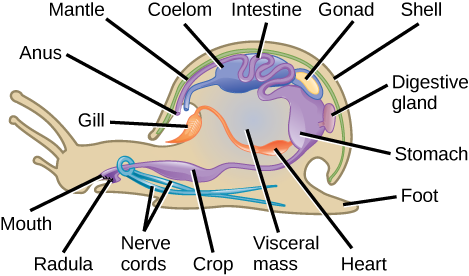
The animals having soft bodies with shell as a covering belongs to
A. Echinodermata
B. Mollusca
C. Porifera
D. None of the above
Answer
483k+ views
Hint: The molluscs have a calcareous shell covering the body. However, a soft and spongy layer of skin is present over the visceral hump of molluscs, forming the mantle.
Complete answer:
Molluscs belong to phylum Mollusca of invertebrates. They are characterized by their soft body. Their body can be divided into three parts: a head, a body and a foot. Due to their soft body molluscs have evolved to possess many protective features as well.
These include the presence of a hard shell (but not all of them have a shell).
Molluscs such as clams, oysters, snails, mussels, and scallops all have shells.
The hard shell protects them from predators.
Additionally, some molluscs have adopted camouflage to protect themselves. There are some molluscs that use poison to paralyze their attackers (like cone snails and octopus).

Additional information: Mollusks can be divided into seven classes:
Aplacophora, Monoplacophora, Polyplacophora, Bivalvia, Gastropoda, Cephalopoda, and Scaphopoda.
These classes are differentiated by, among other criteria, the presence and types of shells they possess.
Therefore, the correct answer is option B. Mollusca.
Note: The soft body makes it difficult for molluscs to adhere to the substratum in terrestrial and in marine habitats as well.
Complete answer:
Molluscs belong to phylum Mollusca of invertebrates. They are characterized by their soft body. Their body can be divided into three parts: a head, a body and a foot. Due to their soft body molluscs have evolved to possess many protective features as well.
These include the presence of a hard shell (but not all of them have a shell).
Molluscs such as clams, oysters, snails, mussels, and scallops all have shells.
The hard shell protects them from predators.
Additionally, some molluscs have adopted camouflage to protect themselves. There are some molluscs that use poison to paralyze their attackers (like cone snails and octopus).

Additional information: Mollusks can be divided into seven classes:
Aplacophora, Monoplacophora, Polyplacophora, Bivalvia, Gastropoda, Cephalopoda, and Scaphopoda.
These classes are differentiated by, among other criteria, the presence and types of shells they possess.
Therefore, the correct answer is option B. Mollusca.
Note: The soft body makes it difficult for molluscs to adhere to the substratum in terrestrial and in marine habitats as well.
Recently Updated Pages
Glucose when reduced with HI and red Phosphorus gives class 11 chemistry CBSE

The highest possible oxidation states of Uranium and class 11 chemistry CBSE

Find the value of x if the mode of the following data class 11 maths CBSE

Which of the following can be used in the Friedel Crafts class 11 chemistry CBSE

A sphere of mass 40 kg is attracted by a second sphere class 11 physics CBSE

Statement I Reactivity of aluminium decreases when class 11 chemistry CBSE

Trending doubts
10 examples of friction in our daily life

One Metric ton is equal to kg A 10000 B 1000 C 100 class 11 physics CBSE

Difference Between Prokaryotic Cells and Eukaryotic Cells

State and prove Bernoullis theorem class 11 physics CBSE

What organs are located on the left side of your body class 11 biology CBSE

How many valence electrons does nitrogen have class 11 chemistry CBSE




